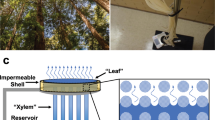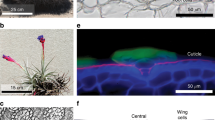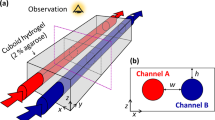Abstract
Plant scientists believe that transpiration—the motion of water from the soil, through a vascular plant, and into the air—occurs by a passive, wicking mechanism. This mechanism is described by the cohesion-tension theory: loss of water by evaporation reduces the pressure of the liquid water within the leaf relative to atmospheric pressure; this reduced pressure pulls liquid water out of the soil and up the xylem to maintain hydration1,2,3. Strikingly, the absolute pressure of the water within the xylem is often negative, such that the liquid is under tension and is thermodynamically metastable with respect to the vapour phase1,4. Qualitatively, this mechanism is the same as that which drives fluid through the synthetic wicks that are key elements in technologies for heat transfer5, fuel cells6,7 and portable chemical systems8,9,10. Quantitatively, the differences in pressure generated in plants to drive flow can be more than a hundredfold larger than those generated in synthetic wicks. Here we present the design and operation of a microfluidic system formed in a synthetic hydrogel. This synthetic ‘tree’ captures the main attributes of transpiration in plants: transduction of subsaturation in the vapour phase of water into negative pressures in the liquid phase, stabilization and flow of liquid water at large negative pressures (-1.0 MPa or lower), continuous heat transfer with the evaporation of liquid water at negative pressure, and continuous extraction of liquid water from subsaturated sources. This development opens the opportunity for technological uses of water under tension and for new experimental studies of the liquid state of water.
This is a preview of subscription content, access via your institution
Access options
Subscribe to this journal
Receive 51 print issues and online access
$199.00 per year
only $3.90 per issue
Buy this article
- Purchase on Springer Link
- Instant access to full article PDF
Prices may be subject to local taxes which are calculated during checkout



Similar content being viewed by others
References
Boehm, J. Capillaritat und Saftsteigen. Ber. Dtsch. Bot. Ges. 11, 203–212 (1893)
Dixon, H. H. & Joly, J. On the ascent of sap. Phil. Trans. R. Soc. Lond. B 186, 563–576 (1895)
Nobel, P. S. Physicochemical and Environmental Plant Physiology 2nd edn (Academic, 1999)
Scholander, P. F., Hammel, H. T., Bradstreet, E. D. & Hemmingsen, E. A. Sap pressure in vascular plants: Negative hydrostatic pressure can be measured in plants. Science 148, 339–346 (1965)
Peterson, G. P. An Introduction to Heat Pipes: Modeling, Testing, and Applications (Wiley, 1994)
Chen, J., Matsuura, T. & Hori, M. Novel gas diffusion layer with water management function for PEMFC. J. Power Sources 131, 155–161 (2004)
Karan, K. et al. An experimental investigation of water transport in PEMFCs: The role of microporous layers. Electrochem. Solid State Lett. 10, B34–B38 (2007)
Effenhauser, C. S., Harttig, H. & Kramer, P. An evaporation-based disposable micropump concept for continuous monitoring applications. Biomed. Microdevices 4, 27–32 (2002)
Guan, Y. X., Xu, Z. R., Dai, J. & Fang, Z. L. The use of a micropump based on capillary and evaporation effects in a microfluidic flow injection chemiluminescence system. Talanta 68, 1384–1389 (2006)
Juncker, D. et al. Autonomous microfluidic capillary system. Anal. Chem. 74, 6139–6144 (2002)
Atkins, P. & de Paula, J. Physical Chemistry 7th edn (Oxford Univ. Press, 2002)
Jacobsen, A. L., Pratt, R. B., Ewers, F. W. & Davis, S. D. Cavitation resistance among 26 chaparral species of southern California. Ecol. Monogr. 77, 99–115 (2007)
Debenedetti, P. G. Metastable Liquids (Princeton Univ. Press, 1996)
Caupin, F. & Herbert, E. Cavitation in water: A review. C. R. Phys. 7, 1000–1007 (2006)
Hayward, A. T. J. Mechanical pump with a suction lift of 17 metres. Nature 225, 376–377 (1970)
Askenasy, E. Beitrage zur Erklarung des Saftsteigens. Verh. Naturhist. Med. Ver. Heidelberg 5, 429–448 (1896)
Guan, Y. & Fredlund, D. G. Use of the tensile strength of water for the direct measurement of high soil suction. Can. Geotech. J. 34, 604–614 (1997)
Aybar, H. S., Egelioglu, F. & Atikol, U. An experimental study on an inclined solar water distillation system. Desalination 180, 285–289 (2005)
Thut, H. F. Demonstration of the lifting power of evaporation. Ohio J. Sci. 28, 292–298 (1928)
Machin, W. D. A simple method for the generation of negative pressure in liquids. Can. J. Chem. Rev. Can. Chim. 76, 1578–1580 (1998)
Flory, P. J. Principles of Polymer Chemistry (Cornell Univ. Press, 1955)
Arce, A., Fornasiero, F., Rodriguez, O., Radke, C. J. & Prausnitz, J. M. Sorption and transport of water vapor in thin polymer films at 35 degrees C. Phys. Chem. Chem. Phys. 6, 103–108 (2004)
Brinker, C. J. & Scherer, G. W. Sol-gel Science: The Physics and Chemistry of Sol-Gel Processing (Academic, 1989)
Herbert, E., Balibar, S. & Caupin, F. Cavitation pressure in water. Phys. Rev. E 74, 041603 (2006)
Zwieniecki, M. A., Melcher, P. J. & Holbrook, N. M. Hydrogel control of xylem hydraulic resistance in plants. Science 291, 1059–1062 (2001)
Holbrook, N. M. & Zwieniecki, M. A. Embolism repair and xylem tension: Do we need a miracle? Plant Physiol. 120, 7–10 (1999)
Errington, J. R. & Debenedetti, P. G. Relationship between structural order and the anomalies of liquid water. Nature 409, 318–321 (2001)
McDonald, J. C. & Whitesides, G. M. Poly(dimethylsiloxane) as a material for fabricating microfluidic devices. Acc. Chem. Res. 35, 491–499 (2002)
Acknowledgements
We thank M. A. Zwieniecki, N. M. Holbrook, P. J. Melcher, C. Cohen, K. J. Niklas, C. Cottin-Bizonne, A. Lassiter and F. Caupin for discussions and suggestions. We thank G. Swan and E. Velez-Rosa for technical assistance with experiments. Support was provided by the Office of Naval Research Young Investigator Program and the Camille and Henry Dreyfus Foundation. T.D.W. acknowledges partial support by a graduate fellowship from the Corning Foundation. The experiments made use of the following facilities: Cornell NanoScale Science and Technology Facility (a member of the National Nanotechnology Infrastructure Network, supported by the National Science Foundation (NSF)), the Nanobiotechnology Center (supported by the STC Program of the NSF under Agreement No. ECS-98767710) and the Cornell Center for Materials Research (supported by the NSF under Award No. DMR-0520404).
Author Contributions A.D.S. conceived the project. Both authors designed the experiments. T.D.W. executed the experiments. Both authors wrote the manuscript.
Author information
Authors and Affiliations
Corresponding author
Supplementary information
Supplementary Information
The file contains Supplementary Methods, Supplementary Figures 1-2, Supplementary Tables 1-2, Supplementary Equations S1-S11 and Supplementary Notes which contain additional information on assumptions stated in the text as well as the derivation of the mathematical relations that are presented in the text. (PDF 354 kb)
Rights and permissions
About this article
Cite this article
Wheeler, T., Stroock, A. The transpiration of water at negative pressures in a synthetic tree. Nature 455, 208–212 (2008). https://doi.org/10.1038/nature07226
Received:
Accepted:
Issue Date:
DOI: https://doi.org/10.1038/nature07226
This article is cited by
-
Solar-driven membrane separation for direct lithium extraction from artificial salt-lake brine
Nature Communications (2024)
-
Mucus Transpiration as the Basis for Chronic Cough and Cough Hypersensitivity
Lung (2024)
-
Hydration solids
Nature (2023)
-
High-efficiency bio-inspired hybrid multi-generation photovoltaic leaf
Nature Communications (2023)
-
Transpiration-inspired Capillary for Synchronous Synthesis and Patterning of Silver Nanoparticles
Chemical Research in Chinese Universities (2023)
Comments
By submitting a comment you agree to abide by our Terms and Community Guidelines. If you find something abusive or that does not comply with our terms or guidelines please flag it as inappropriate.



